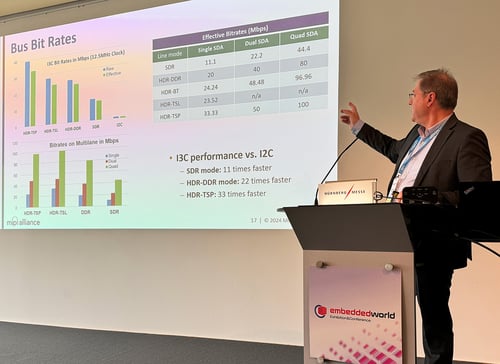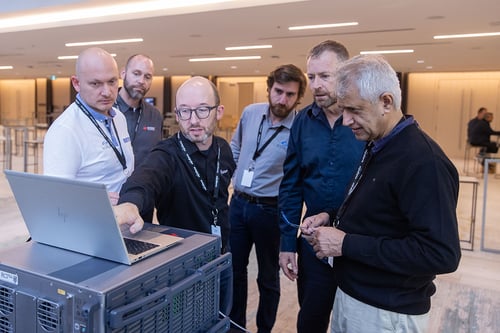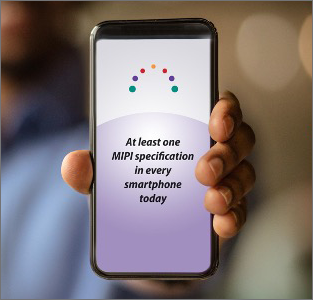MIPI CSI-2®
MIPI Camera Serial Interface 2
.png?width=1200&height=600&name=Banner%20Images%20-%20MIPI%20(1).png)
Developed by: Camera Working Group
A widely adopted, high-speed protocol for transmission of still and video images from image sensors to application processors
Quick Facts
-
Advantages
De facto high-speed camera and imaging interface supporting a broad range of use cases, platforms and application areas
-
Physical Layers
-
Use Cases
- Machine vision
- Imaging
- Contextual awareness
- Biometric recognition
- Surveillance
- ADAS and in-vehicle infotainment
Industries
Get the Specification
-
Current Version
MIPI CSI-2® v4.1 (April 2024)
Member version
-
Conformance Test Suite
Available to MIPI members:
CTS v1.0 for MIPI CSI-2 v4.1
Receiver CTS
Transmitter CTSSee previous test suites on the member website.
-
Related Specifications & Code
Related Specifications:
- MIPI Camera Command Set (MIPI CCS)
- MIPI Camera Service Extensions (MIPI CSE)
- MIPI Camera Security Specification
- MIPI Camera Security Profiles
- MIPI DisCo for Imaging
- MIPI A-PHY Protocol Adaptation Layer for CSI-2 (MIPI PAL/CSI-2)
Code Projects:
- MIPI Camera Command Set (CCS) Tools
(Developed by the MIPI Software Working Group) - Multi-Pixel Compression (MPC) Example Code

-
Previous Versions
Available to MIPI members:
CSI-2 v4.0.1
CSI-2 v4.0
CSI-2 v3.0
CSI-2 v2.1
CSI-2 v2.0
CSI-2 v1.3
CSI-2 v1.2
CSI-2 v1.1
Overview
MIPI CSI-2®, originally introduced in 2005, is the world’s most widely implemented embedded camera and imaging interface. It has achieved widespread adoption for its ease of use and ability to support a broad range of high-performance applications, including 1080p, 4K, 8K and beyond video, and high-resolution photography.
Designers should feel comfortable using MIPI CSI-2 for any single- or multi-camera implementation in far-ranging application spaces such as mobile, augmented and virtual reality, drones, the Internet of Things (IoT), medical devices, industrial systems, automobiles and client devices such as tablets, notebooks and all-in-ones.
The CSI-2 specification is available only to MIPI Alliance members. For information about joining MIPI Alliance, visit Join MIPI.
Fundamental Features
- High performance
- Low power
- Low electromagnetic interference (EMI)
Implementation
CSI-2 is lane-scalable and typically implemented on either a MIPI C-PHY℠ or MIPI D-PHY℠ physical-layer interface for shorter-reach applications, but it also can be implemented over the MIPI A-PHY® long-reach SerDes interface (up to 15m) for use in such applications as automotive advanced driver-assistance systems (ADAS) and in-vehicle infotainment, as well as industrial IoT.
All versions of CSI-2 are backward compatible with previous versions.
Key CSI-2 Features
The CSI-2 interface offers a wide range of other valuable performance attributes:
- The option to use up to 32 virtual channels accommodates the proliferation of image sensors with multiple data types, and supports multi-exposure and multi-range sensor fusion for applications such as enhanced collision avoidance in automotive.
- Latency Reduction and Transport Efficiency (LRTE) provides image-sensor aggregation without adding to system cost; facilitates real-time perception, processing and decision-making; and optimizes transport to reduce the number of wires, toggle rate and power consumption.
- Differential Pulse Code Modulation (DPCM) compression reduces bandwidth while delivering superior SNR images devoid of compression artifacts for mission-critical vision applications.
- Scrambling reduces Power Spectral Density (PSD) emissions, minimizes radio interference and allows further reach for longer channels.
- Smart Region of Interest (SROI)for analyzing images, inferencing algorithms and making better deductions could enable machines on a factory floor, for example, to more quickly identify potential defects on a conveyor belt, or medical devices to more surely recognize anomalies such as tumors.
- Unified Serial Link (USL) encapsulates connections between an image sensor module and application processor to reduce the number of wires needed in IoT, automotive and client products for productivity and content creation, such as all-in-one and notebook platforms.
- The capability of the Camera Control Interface (CCI) to work with the MIPI I3C/I3C Basic interface supports advanced imaging performance requirements for auto focus and optical image stabilization (OIS), among other applications.
Version Updates
Version 4.1
Version 4.1 adds enhanced support for applications leveraging artificial intelligence (AI) or requiring ultra-low energy consumption. Key updates include:
- Alignment with MIPI C-PHY v3.0: CSI-2 v4.1 offers protocol support to align with C-PHY v3.0’s new 18-Wire-State Mode coding option and other benefits, such as reduced link requirements and lower electromagnetic interference (EMI), when they become available to members.
- Reduced energy consumption: CSI-2 over C-PHY will enable lower symbol rates or lane counts for existing use cases, or higher frame rates for new use cases involving very high-end cameras and sensors, such as AI-assisted scene analytics inferencing.
- Expanded support for Always-On Sentinel Conduit (AOSC): Version 4.1 of CSI-2 adds normal I3C read commands as another option for reading AOSC image frames while in an I3C High Data Rate (HDR) mode to further simplify implementation.
- Addition of annex sections: Version 4.1 includes high-data-width PHY Protocol Interface (PPI) examples for both C-PHY and MIPI D-PHY.
Version 4.0.1
Version 4.0.1 replaces MIPI deprecated technical terms with more inclusive wording.
Version 4.0
CSI-2 v4.0 delivers significant updates designed to enable greater capabilities for machine awareness across multiple application spaces. It is also the first to support transmission of CSI-2 image frames over the low-cost, low-pin-count MIPI I3C®/I3C Basic℠ two-wire interface. New features include:
- Always-On Sentinel Conduit (AOSC), which enables always-on machine vision systems in which combinations of ultra-low-power image sensors and video signal processors (VSPs) can continuously monitor their surrounding environments and then wake their higher-power host central processing units (CPUs) only when significant events happen. AOSC enables image frames to be economically streamed from an image sensor to a VSP over a low-power MIPI I3C bus in a highly efficient manner, with scaling options to add extra I3C lanes and bandwidth as defined by the I3C specification.
- Multi-Pixel Compression (MPC), which provides optimized pixel compression for the latest generation of very-high-resolution Tetra-Cell and Nona-Cell image sensors with multi-pixel color filter arrays (CFAs).
- RAW28 color depth pixel encoding, which supports unprecedented image quality and superior signal-to-noise (SNR) ratio in the next generation of high-dynamic-range automotive image sensors for safety-critical applications. (Previous versions offer support for up to RAW 24.)
Diagrams & Tables
Click to enlarge
Resources
Resources for Developers
MIPI Camera Week - Exploring Imaging System Design Considerations for CSI-2 Over D-PHY and C-PHY
Updated - MIPI White Paper: An Introductory Guide to MIPI Automotive SerDes Solutions (MASS)
Article: Camera Security Framework Addresses Regulatory Requirements
Article: New Developments in MIPI’s High-Speed Automotive Sensor Connectivity Framework







